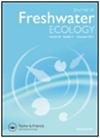Bosmina fatalis adapting to ammonia through oxidative stress and ribosome increase
IF 1.3
4区 环境科学与生态学
Q3 ECOLOGY
引用次数: 0
Abstract
Abstract Ammonia is generated in large quantities during organic degradation, concluding that of cyanobacteria, which is toxic to aquatic animals. B. fatalis is a widespread cladoceran species found in freshwater. The present study aimed to explore the toxic responses of B. fatalis to ammonia. Our experiments showed that the 24, 48, 72 and 96 h LC50 values of NH3 on B. fatalis were 20.59, 13.06, 5.77 and 3.36 mg·L−1, respectively. A 14-days NH3 exposure study at 0, 0.22, 0.57 and 1.4 mg·L−1 were carried out. NH3 at low and medium doses (0.22 and 0.57 mg·L−1) displayed stimulative effects on the B. fatalis population and the body length of the newborns, while NH3 at high dose (1.4 mg·L−1) did not exhibit significant effect on the B. fatalis population and size. Transmission electron microscope (TEM) revealed significant increase in number of ribosomes at low doses, while the interior structure showed no marked change at high dose. The levels of indicators related to oxidative stress (ACP, SOD, CAT, GSH-Px and MDA) caused by NH3 first increasedand, then decreased with time in all the NH3-exposure groups. The mRNA expression of genes related to ribosomal structure (RPL12, RPL10, RPL10A, RPL27A and RPL19) and antioxidant stress (CAT, SOD and GSH-Px) was rapidly downregulated after NH3 exposure. Collectively, it is inferred that ammonia at a certain dose (≤0.57 mg·L−1) stimulates the growth and reproduction of B. fatalis, which may be its defensive reaction to ammonia. Graphical AbstractBosmina fatalis通过氧化应激和核糖体增加适应氨
摘要有机降解过程中会产生大量氨,这是蓝藻对水生动物有毒的结论。B.fatalis是一种广泛分布于淡水中的分支角类物种。本研究旨在探讨致命芽孢杆菌对氨的毒性反应。我们的实验表明,24、48、72和96 NH3对B.fatalis的LC50值分别为20.59、13.06、5.77和3.36 mg·L−1。在0、0.22、0.57和1.4条件下进行的为期14天的NH3暴露研究 mg·L−1。低剂量和中等剂量的NH3(0.22和0.57 mg·L−1)对B.fatalis种群和新生儿身长均有刺激作用,而高剂量NH3(1.4 mg·L−1)对B.fatalis种群和大小没有显著影响。透射电子显微镜(TEM)显示,低剂量时核糖体数量显著增加,而高剂量时内部结构没有明显变化。NH3引起的氧化应激相关指标(ACP、SOD、CAT、GSH-Px和MDA)水平随时间的推移先升高后降低。NH3暴露后,与核糖体结构(RPL12、RPL10、RPL10A、RPL27A和RPL19)和抗氧化应激(CAT、SOD和GSH-Px)相关的基因的mRNA表达迅速下调。总的来说,可以推断氨在一定剂量下(≤0.57 mg·L−1)刺激蛇床子的生长和繁殖,这可能是其对氨的防御反应。图形摘要
本文章由计算机程序翻译,如有差异,请以英文原文为准。
求助全文
约1分钟内获得全文
求助全文
来源期刊
CiteScore
2.20
自引率
7.70%
发文量
34
审稿时长
3 months
期刊介绍:
The Journal of Freshwater Ecology, published since 1981, is an open access peer-reviewed journal for the field of aquatic ecology of freshwater systems that is aimed at an international audience of researchers and professionals. Its coverage reflects the wide diversity of ecological subdisciplines and topics, including but not limited to physiological, population, community, and ecosystem ecology as well as biogeochemistry and ecohydrology of all types of freshwater systems including lentic, lotic, hyporheic and wetland systems. Studies that improve our understanding of anthropogenic impacts and changes to freshwater systems are also appropriate.

 求助内容:
求助内容: 应助结果提醒方式:
应助结果提醒方式:


